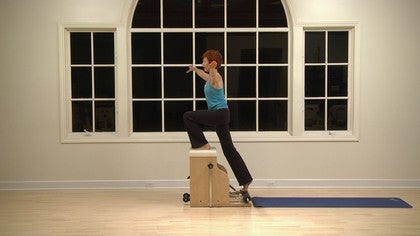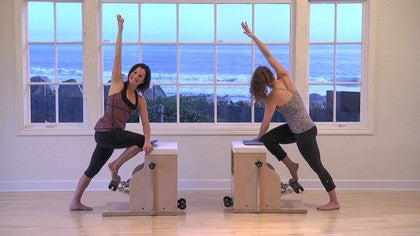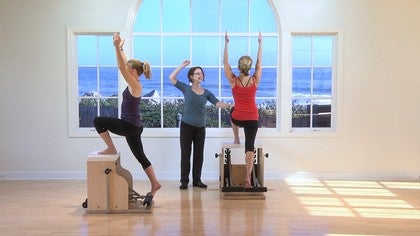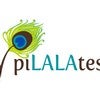Description
About This Video
Transcript
Read Full Transcript
So, uh, we'll be doing a chair routine this evening. I thought I'm to incorporate some of the more, uh, traditional exercises and some of art, the archival exercises just to make it a little bit more interesting and varied. So to start out, I always like it just gentle, warm up. So a few roll-ups just to loosen up the spine, lengthening up, attempting to keep the arms right by the ears, scoping just to warm up my back. Exhaling on the way out, up. I mean inhaling, exhaling down, exhaling, inhaling, exhaling down, inhaling and exhaling.
Inhaling and exhaling. Now coming up again, this is just a few, just to create a bit of a warmup. The series of five in a more challenging way with the back off the edge of the chair just means that if the trunk is not really stable, you collapse that. So of course you don't want to do that. If you feel unsure, sure. You bring yourself further in. If you want to challenge yourself, you move a little bit further out. So anchoring the powerhouse, making sure the shoulders are engaged, just a few repetitions to loosen up the legs and get anchored. Then to go a little bit deeper, going lower, almost going beyond the height of the chair to allow the hip flexors to open up a little bit, so double leg stretches. A nice way to help the body get anchored is if you grab the edge of the chair and you use it to deepen the ribs down and open up the back body.
Really lengthening the back, but contracting in the front. So starting out from here, long stretch, long stretch, and then adding in to add a challenge, keeping the power house anchored. Big Circle coming up. One more time. Lifting the chest, going parallel, going further back into back bend and gathering right back into the powerhouse again for scissors, making sure that the back is long. The front body is really holding the weight and first of all, simple scissors. Making sure the pelvis is stable. Then starting to add more length through the legs. Every time the leg goes down, lengthening through the hip flexor and a few with the legs flexed to just give the muscles more extension, more stretch than lower lift, lifting up through the powerhouse, lowering the legs,
So on this chair we have four springs. I'm working with the two inner springs with the attachments on high, starting out with the legwork. So be careful to really make sure all five toes or spread an extended on the ledge heals together. And first variation, I'm going to have the hands behind so it can really work to keep the chest nice and open. And as I press down, I'm going to hold her for a minute. Check that I'm balanced on both legs, length in the trunk, open the collarbones and then resist the pressure of the chair up. So I'm going down and resisting coming up.
So it's a subtle intention on my part, not to give into the spring, which encourages that the legs stick become the muscles to really hug to the bone and lengthen out at the same time without the spine shifting. So the whole time I'm pressing up through the crown in my head. Now shifting to parallel again, I'm making sure that all five toes are evenly spread so that the pressures on the little toe and the big toe off of the little toe is left off in the air. So this whole outer line of the foot is under worked. I'm making sure that side's very active.
The knee is lined up through the center of the foot. Ideally my heel is going right back. Now I'll bring the hands in front, lift the spine up. Same thing pressing down. Gonna adjust my feet slightly. So I really have a good pressure in through the ball of the foot. Banks in the back end. Resist, stop, press down, pull the stomach and powerhouse up and resist coming up. I'm also working very hard to keep my heels lifted and this the front shinbone muscles straight and long. So I know that often the leg, the front leg could be quite varied for people.
They can have short parts of the leg and long part and this is extremely therapeutic to restrengthen ankles, feet, knees, hips as you pay it into the track, the legs in the bones evenly and nicely and coming back up, adjusting just below the ball, extending my toes down, bird on a purchase, same thing. So my focus right now is to really lift my spine up and I'm going to work without hands. So increasing the challenge every time and the focus is every time the legs go down, I'm lengthening my trunk up and the rhythm of this exercise can be done in a lot of different ways. Do it very fast, very slow. Moving on to heels depending upon what effect you want to create.
If you want to create speed and heat, you can work fast. I really enjoy fast workouts, a time they stimulating the uplifting, the slower, more methodical workout, lot of care and attention to technique, correct alignment and training the body to be organized and efficient in its movements. This one can be done also with the arms up, so different variations for the hands to challenge the body at another in different ways. Now moving back, finger leg back on the balls of the feet, extending one leg in front of me. Trying to get the foot in line with the hip, lengthening the spine up and pressing down with one leg six times. Again, making sure my knees tracking right over the center of the foot. Changing side, lifting up the spine again and again pressing down.
One of my philosophies in life is you can never lift up too much. You can never make too much space in your own body and now for tendon stretch. A nice variation of doing this as pressing down. Keeping my knees exactly even pressing by articulating my ankle. I'm lifting and lowering the ledge without the knees moving.
And then I'm keeping the legs steady and lifting and lowering the knees. The little bit of a brain twister. It's a lot of fun to do and bringing the legs up. Next one is frogs, frogs four, which works very extensively into the upper chest. So the first movement is really to get the shoulders y and push down with the shoulders to activate this whole side of the ribs. The latter. They are really the dominant area that works the same time pulling the knees, um, contracting the knees. So I'm literally squeezing my heels up towards my groin.
So lifting my weight up onto my hands, making sure the chest is open, keeping the heels high, I'm lowering my body down and then pressing it back up. And then I'm pumping three times with the legs without the hips moving again, lowering the body down, lifting the leg up and pumping three times. One more time, not lifting my legs up. I'm lifting my whole trunk up. A lot of work in the upper, in the arms pumping three times and then increasing this by taking one leg to the side, lowering down, lifting up, pumping three times, changing, reaffirming the open chest, really engaging the lats to support the position legs to the side, bending down and pumping three times. Not Easy to do. Oh, okay. Gosh, my legs are working now.
So from here pressing down and going into tendon stretch and pull ups, I'm going to turn the chair sideways.
Then deepening into the powerhouse, making sure the shoulders are right over the wrists, lifting up and pumping here three times.
And depending upon what kind of chair you have, you may need to anchor it. If somebody, if you're practicing with somebody else or training somebody, chair doesn't go flying forward. So next version is angled pull ups. You want the shoulders over the wrists. What I'm looking for is two shoulders and two hips, even distance from the frost. So there's a slight I agonal and first of all I'm bringing my feet together.
So hugging the midline, lifting way up and lowering down the quite extensively into the obliques can also be done with the foot hooked. And you can add pumps to this. So lifting up, pumping three times up with the hips up with the hips, and you check that the hips or even the other variation is with the outside foot on the ledge inside foot next to it. So same concept, the hips and the shoulders or even distance from the floor pulling up again all the way up, all the way up. You can have the foot hooked all the way up and again, pumping three times and then lowering down with control. So the same thing on the other side. First of all, standing on the inner foot.
Outer foot is pressed in the hands on either side of the ledge and the shoulders are even distance from the flow. So there's this slight diagonal in the trunk and you're looking to keep the hips even distance from the floor as well. Then deepen and lifting through the powerhouse, pulling the hips up and down with control, pulling the hips up. So lot of work into the obliques, really pulling the hips way up, attempting to get to the top of the spring, bringing my foot in for another variation of the same one pulling all the way up, then pumping three times pump pump and lower down. And same thing with standing on the inside foot.
So feet are together, shoulders are even distance from the floor. Slight diagonal in relation to the hands and lifting up again up to the top of the spring every time pulling the stomach and the waist up. And last one is with the foot hooked up and pumping three times pump and then lowering the body down, turning to face the center, pressing the heels down, stretching out again just to get a nice stretch and work out the spine and one foot comes down and with care other foot comes up. Now from here, spine stretch forward. Let me pull this mat in front of the chair.
So next exercise is spine stretch forward and as it's an arm exercise, the spring tension has to be lighter. I am moving and removing one spring, so I have one high spring. And personally from experience, I found that different chairs have different spring tonality. So a general rule of some legwork is two springs. Arm work is one spring, but within that there's a lot of variables that I like to test on people's bodies before I have a rule that this is the correct tension as the beauty of this apparatus as being able to adjust it so it serves the person. So starting out nice and tall, I'm lifting my spine up, taking a deep breath in and then pulling the powerhouse in and up.
I'm slightly bending the arms and using it to create length in the waste. The waste is lifting, the ribs are lifting, but I'm opening up the back body and then lengthening out and again, big breath in and breathing out, compressing the front body and lifting in the powerhouse coming back up. And one more time. Same thing. Big Lift first of all. And so a lot of it's less arms and it's a lot of powerhouse to pull this back, open the back body and broaden through the shoulder blades coming up. Now a nice variation of this is with the hands in.
This is an archival version where you press down even more and you use the pressure down to lift the spine and then coming back up. So as I go down and widening through the shoulders and lifting up the back body, opening up through the shoulder blades. One more time like this, pressing down, lifting and bending a little bit deeper, coming in over the step to open up the spine and then lifting back up. Single arms is less a powerhouse. It's more about stabilization of the spine to nice lift through the back.
Stomach is pulled up and supporting the back. And I've just pressing down three times. I have my hand close to the center so it's not exactly in the center of my body, but close to the center line. So of my center line is here. My hand is maybe an inch from the center, but it's crossed over my body. So big lift pressing down.
And the beauty of this is that really starts to get the lat working and really create a lot of support through the shoulder girdle. Love this one. Okay, next one is teaser. Everybody's favorite. So few variations. Archival version. The feet of the arches are on so first and the knees are actually bend and then as I press down, I'd bend in and lift and crow in a little bit and lift and curl in and lift. Then moving into the heels being higher, the legs are longer. This one pulling back and up through the sponsor spine stays longer.
Lifting the legs, lowering the legs and coming back up. The beauty of teaser on the chair like this, I have found that some people complain they can't feel the stomach muscles and they can't find the lower abs at all. No matter what exercise they tried to. When I put them into this one, they see the light because it's all, I've never had somebody not go, oh my God, does this ever make my lower abs work? So it's wonderful to stimulate that area. And for some people it's a little hard to find it. So moving into back on pumps, pressing the ledge down, seeing if I can get my hands almost under my shoulders.
Very important to keep the shoulders as wide as possible and if possible, bringing the elbows back so you're almost a striving for 90 degree angle. That's the goal. And if the muscles are tight, you're working with that intention in mind. So dice, lift through the chest and then lifting the arms back and up to stretch the shoulders and open up across the collarbones. Every time the arms go down, the chest lifts a little bit more. It's working way up. Now if a person has very tight hamstrings, we'll sometimes have them sit and sometimes even put a ledge under their bottom so they have a chance of having a straight spine because if the hamstrings are really tight, the person will be like this. And this doesn't really defeats the purpose of the exercise.
You want that beautiful lifted spine. So this works the triceps and the arms. It also stretches across the collarbones nicely. So releasing, letting the LEDs go up. Next one is flying ego.
One of my favorite exercises. So again, with one spring in the high volume, the arms are parallel. Starting out if possible, you want the ledge fully lifted. The hands parallel and the head forehead on the mat now pulled a lot of people. That's an unreal requirement because the shoulders are tight, in which case their hands can go wider. If you have a cheer like this with a stick, you can have the hands even wider, which will help them get a lovely stretch across the pecks in the front of the shoulders and start to release all of that tension that they have.
So the legs along the spine is long. The powerhouses lifted. First movement is the head of Chesko come up and the shoulders come down the spine and then keep pulling the shoulders back and down to help press the chest up. So beautiful work into the ribcage and the chest than staying up nicely. Lengthening the spine out and dropping the head all the way down. Beautiful stretch. I love this one. Lift the head up, pull the shoulders down the back and keep, it's this retraction of the shoulders down to open the chest to make the lats and upper back work and then lengthening all the way down. Nothing.
The forehead drop. One more time. Lifting the head, pulling the shoulders down and pressing up. Now once I'm up here, this is the third variation. Pressing, pumping the arms every time. Get that chest a little bit higher, making sure the legs are stay long, the hip sustained compact and the stomach is lifting out of the lower back and then lengthening out and lengthening out, lengthening out, relaxing down. Now this next one's a little bit of a archival variation. Definitely intermediate to advanced exercise. An exercise if the person needs enough flexibility to be challenged with it. If they have it, they love it, which is just simply same stretch a little bit for the back with the body.
Lifting the legs up in the air as well, which throws the weight further forward, makes them hamstrings and glutes work extensively. So starting out, same way legs along, lifting the legs and pressing down so a lot more work through the whole body. My chair just slid forward. Okay, and one more time. Legs come up. Eventually the weight stays further forward on the, towards the navel. When the legs are down, the weight is further back. The legs coming up mean the upper weight is distributed more evenly through the spine. And let me stretch back and get my ball good stretch and come back up to an upright position.
So working slightly into the obliques and side body. I'm going for kneeling mermaid. I'm going to take my officer's side. So getting the sense of being very even on both legs. The chest is open, the soldiers are down, keeping the knees straight, bending all the way down. Placing the hand ae here in front of my shoulder line.
This is right to the side, a little bit forward. Big rotation of the arm. This rotation pulls the shoulder blade away from the spine and wraps the tricep around, which is very useful to opening up the side ribs versus here, which starts to tighten into the neck. So nice rotation of the arm, big lift and then starting to press the right shoulder down and contract on the right side as I open up the left side of the body, some beautiful opening in the side body coming back up, lengthening in the waist, even more very from hips. The hips ideally do not move. So the whole bend happens in the spine above.
And what I'm looking for is this opening on the, in my case on the left side of my body opening in the waist, opening in the hips, especially opening in the rib cage so each intercostal muscle is being stretched to challenge that further. I can press this arm down and even take it back to really get those ribs to start to separate and open, giving more room for the lungs and the heart arms come back to the side and standing up, walking around to the other side again, standing on both feet so that as I go down I make sure that I stay even on both feet. Hand is a little in front of me. Nice rotation of the arms. Hips are steady and then pressing down contracting. Now the left side opening up the right side of the ribs. So it's very much of a lateral stretch, lengthening in the waist, seeing if I can go a little bit further and one more time. So my goal isn't necessarily to get the ledge to the floor.
My goal is to open up this, this whole side of the body and get the lungs to have the ribs to separate to the much more room for breath and come back up. Crew wonder and hopefully you come up evenly in nicely. So next one would be Swann and then swan dive. So sitting, lying down, I mean on the Ledge, I'm going to just test this so the shoulders will be right over the wrists and the shoulders are down, the backs of the back is nice and long legs are together, they have a tendency to fall. So the more advanced you are, you want to start lifting them. So they engage all the way into the, into the glutes, in the high part of the hamstrings. And first of all just a few pumps kind of hanging out here.
And then the third one, the shoulders roll back and the body lifts up again, pressing down, deepening through the front body to make sure the front and the back body are even and the nice and broad lifting up. One more time, pressing down and broad shoulders, deepening the shoulders down the back. Now single leg ones are moving the hand slightly and so it's more opposite close to the center line of my body. Maybe an inch sharp. The sternum right arm is exactly out. This harm tends to drift, so you want to be sure that it's right to the side and I'm doing three pumps lifting up, trying to keep my spine very even. This is fantastic for scoliosis and just for spines that have a tendency to be dominant one side more than the other because if you are working with somebody else you completely can assist them by sparking them to stay even in square.
And sometimes a whole muscle group that has not been working gets a chance to be challenged and have to be activated. Other side, this is my funky side, I can feel my wanting to do funny things. So let's see if I can keep myself straight. There is that left side gets lazy once the right side to do all the work and lifting. Oh yes, that feels better. Okay. And I see nice and lift. Okay. So stepping down now, a lot of work in the center now to stretch out and get, give a gentle twist sitting with the legs straight and I'm really pressing the heel of the hand up so the arms are good.
The third finger is touching my arms right above my head, so nice lift up through the spine and then I'll take my left hand and reach out. I'm looking in the direction of the lower arm. This arm is thing right by my ear, the hip stay even as I stretch out, a beautiful stretch on the right side and lift other side, stretching out, coming up and lift for side. Again,
First of all with the legs and table top rolling down and up a few times, so the hips and narrow. Then with the legs straight, same thing
I'm looking to see my head is straight or out of the side bit. A few variations of this. The feet could be linked into, they could be flexed, but the feeling is that the ankles are glued together. So now it's this rib I'm going to be working to pull in to lift up. So it's very much the whole side of the ribs lifting and lengthening at the same time as the powerhouses long. Now I keep the hips square and I bring my hand down so I have a twist.
So it's like you could say swan and the feeling is my right leg is extending away from me. My role writes shoulders, stretching forward, and then I work into the wide legged position to get even more of us twist the hips they stack, but now there's more of a sense of ringing the body out and comes back, bend and come back up and other side. So again, I'm placing my hips right in the center of the chair, looking to see if my both sides of the waist I even the legs are continuation of the spine and then lifting up, pulling the ribs in and up to really work deeply through the trunk muscles, bringing both hands down, attempting to keep the hips square. This is my tighter side and I can feel it working more intensively. So I'm taking a lot of work into my left leg to lengthen it out so I can stretch out that Titus side of my body. Then big stretch with spreading the legs apart, I should say. It's with a special focus on the back leg. It wants to go down.
You want to take it straight back from the hip and make sure both hips are still stacked. The focus here is on this hip pulling down because the ribs are going forward, so it's usually a very popular one because there's a lot of opening that you experience right throughout the ribs. Now another variation of mermaid contracting in this area, sitting with the leg straight in front. I'm leaning a here forward with my hands, so I'm bringing my shoulders over the hips. The other arm is up, keeping both hips down. I'm bending over to the side and stretching down.
So again, it's opening up. This opens much lower. The kneeling mermaid was opening much higher up and then swiveling around to the other side. Same thing, making sure my hips are at the back, the hand is slightly forward. Keeping both hips down on the mat, contracting through the waist. Amazing, beautiful stretch on the upper side, the side that's being opened. Very good. So now walking to the back for pressing down front or Washer woman, I've heard a lot of different names for this one can stand either peril or with your feet and Pilati stance. First of all, nice lift through the whole spine and then curling over, lifting up to the powerhouse, attempting to keep the heels as far forward as possible, and then stretching the spa, the the chair down in some chairs. There's a whole ledge that you can lean into and I can actually lean into it on this chair as well, pumping three times and then keeping the thighs forward, using the powerhouse to lift up or this feels great because I can feel my whole back now opening up, pumping, and then pulling the powerhouse in to lift up. One more time, pressing down and pumping three times, keeping the soldiers away from the ears and pulling the powerhouse in and up to come up.
Now traditionally the thigh stays forward and then you come up with the arms, stand on the legs and bring the arms down so you have this nice vertical position. Now to work a little bit into the hips pressing down. I'm with the leg, I've got, let's check the tension here. This is nice. I've got one high spring, a few variations for the hands. The hands can be at the hips, they can be behind the head, they can be out. I do like them behind the hip on top of the hips I should say, because you can use the pressure of the hands down to get this sense of lifting out of the hips and narrowing. So pressing down, trying to keep the hips nice and steady so that they're not wobbling.
Compressing the hips and pressing down, compressing the hips and pressing down archival variation. You press down deep and Whoa, Ho bend over, come back up and lift the leg the step one more time. A step down. Bend over. So you deepen into the powerhouse. Ben, back up, lift up. That's not, that's a challenge. One. Whoa. I'm challenged here. And then three lifts, one and two and three and change legs.
So real fun. So same thing. Hips are down, spine is long. Chest is open. Three times pressing down. Attempting to keep the hips even and stable. So it's all work through the leg. Inner thighs, working archival version.
Let's see if I do any better. Pressing down. Here we go. I'm starting to figure out how, oh, I need to hold my hips a lot. Lift back up, come back up one more time. Press the ledge down, Bend over with ledge down, keeping the hips. Very steady. Roll back up. Come up. And then three lifts of the legs.
So I'm making sure I'm really on top of my hip. The hips are locked. The powerhouses lifted one too much better. This side I suppose practice does make perfect so side, just the regular ones. I'm looking to keep my hips as square as possible. The more you take your leg to the side, the more challenging in your inner side, but you don't want to do it at the expense of the hip bones.
So for most people the foot will be a little bit forward. Hips are down, so this line is square. Big Lift through the back and then using the inner and outer side, little bit into the glutes, pressing down, almost went too low there. Cause I could feel my hips shift. So as far as I can go down. And then three lifts with the foot lift and lift and lift.
Good other side, the back is long, the hips are square, the standing leg. I'm really lifting up out of its and pulling up out of my inner sigh to give me stability all the way into the hip. And then lifting the legs again, reaffirming my balance here. One lift to lift. Three. Very good. So the, the next one, the leg is behind and it's really the most challenging because of the complexity of the alignment and the joints.
I will often put a chair in front of a person so there's something they can hold onto or stand in front of them and hold their hand because it takes a little bit of maneuvering to find your balance and stretch. So the most important thing what you're working for is getting the hips square as much at the back leg straight. But then this huge lift through the front body. So the spine is lifting up, even though there's that slight tendency for compression from the back. So keeping this lift, working through the hamstring and the glutes pressing down, and then keeping that lift, seeing if you can lift the leg, lift the leg, lift the lake and other side. Let me get my leg back there. Very good.
Squaring my hips, lifting up on this standing leg side as much as possible, and then lengthening out. So lifting the stomach up, things coming out of the back body, making sure the shoulders stay open, pressing down three times. Woopsie daisy, staying balanced on that standing leg, keeping the stability up through this side that's actually connected to the floor. And then lifting, lifting, lifting and standing down. Oh, that was great. So now stepping up front, the grand finale. Yes. My teacher used to say, I'm going to add this as another spring. So one high, one low, cause I'm back to legwork and standing in front of the chair, pushing it down with one leg and then stepping up. Now you're more beginner. Whoa, Whoa, whoa. You would press a step down, bend over so you have a nice stability. Make sure your trunk is even put your foot up in front.
I'm lining my foot near the center line of the chair. Sometimes you can have the foot in Pilati stamps or Powell, depending upon what your priority is and then lifting my body up. Now the knee should not go further than the toes. It should stay above the toe with the weight more into the heel, so to start I'm lifting my heel up high, anchoring my hips so that they are stable. Point in, lengthening through the spine and then lifting up and lifting up. So a lot of work, a lot of the prep work for this is done with the high chair. If you have that kind of a chair in the studio because you're really strengthening the squad and lifting up, then step, putting your hands down, bringing the foot down and changing other side.
Again squaring the hips, making sure the knee is not going beyond the toe, but right over it, I'm anchoring my hips together so I'm taking them and clamping them and then lifting up. So there's a lot. I'm even using energy with my hands down to help stabilize my body.
I have two high springs. So yeah, it's a little bit more tension and doing the more advanced version again, stepping debt, pushing the step down and stepping up. So same principle going up and down five times.
Reaching back for the invisible step. There it is. Yay. Stepping down, stepping down to the floor and lifting up. So everything without hand and then reversing it. So pressing the step down and stepping up, making sure I'm anchored in five times coming up. So my really focusing a lot on my whole trunk to keep it very stable.
Now really lifting up that right side. Once the right leg and hip is stable, work the other leg up. Bring the leg in front of me, big circle around, reach back and hope I find the step before I fall apart, which is not supposed to happen ever. And then step down and lift up slow and with control and I survived. I did it. Thank you very much. I hope you enjoy everything as well.
Wunda Chair Workouts: Intermediate Classes
Comments
Linda Padilla
You need to be a subscriber to post a comment.
Please Log In or Create an Account to start your free trial.


























